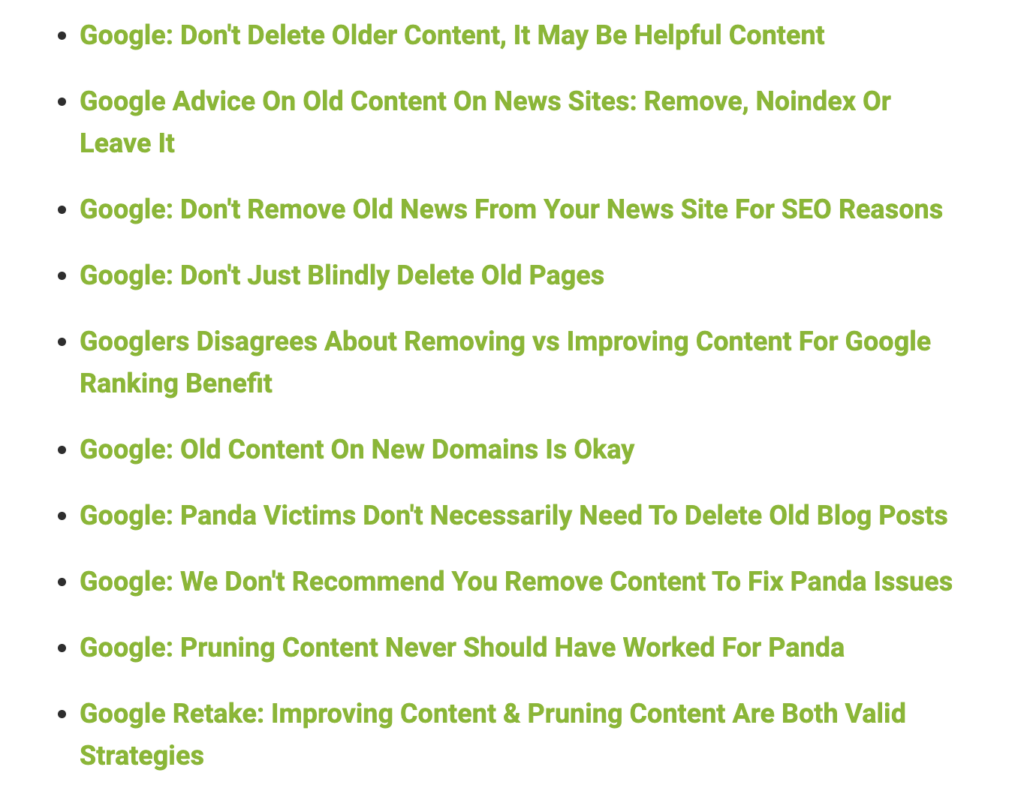

Content pruning: When and how to remove decayed content
It’s not a surefire path to SEO stardom, but content pruning done correctly can improve your website’s performance.

Written by Lee Way Lin | Graphics by Yusak Prahadi
You must have heard about CNET’s controversial deletion of thousands of pages of content and old news last year, as well as the polarised commentary around the tech news giant’s decision.
With Google’s roll-out of its revised algorithm, Panda 4.1 on 25 September 2023, numerous content sites noticed that they were negatively affected by the search engine’s new rules. Many have sought to re-optimise their site’s SEO.
One of these methods is called content pruning, and it’s quickly gaining attention – too much attention, in some cases – for being an efficient way to sharpen your brand voice while being able to operate within Google’s new system.
What are we pruning?
The process of content pruning means you will be conducting a full content audit on your website, and then making the decision to improve or remove underperforming, outdated, or low-quality content.
It’s still a practice that divides marketing and SEO experts. Just look at the wildly oscillating headlines in the screenshot below. But, there’s definitely been an increasing opinion that websites publishing think pieces will benefit from taking stock of what’s in their content inventory from time to time.

Whether or not content gets refreshed or removed ultimately depends on how useful it is to your readers, as well as how aligned it is to your brand voice. Think of this exercise as an opportunity to clarify the direction and authority of your website, instead of a panicked attempt to retain search relevance.
Pruning to flourish
The benefits of content pruning can be tremendous, as seen in this SEO consultancy’s use of content pruning to help revitalise traffic to their client’s website. Content pruning can reverse traffic loss to your channel and even increase traffic year-on-year. It can also increase implementation rate, and the number of hits to the priority site section of your domain.
Beau Pedraza, Founder at The Cube Farmer, notes that his process of the content audit is always to first “assess the intent of the article’s theme and compare it to the website’s main reason for existence”.
Pruning content can also give your audience a more coherent, enjoyable user experience. No more links that lead to nowhere, no more discussions that end in cliffhangers with no valuable takeaways or payoffs. Just authentic, complete, and compelling content.
The content audit
If you’ve decided to go ahead with content pruning, you should first make a list of content pieces you currently have on your website. You now have two things to do:
- Judge which pieces need to be improved or removed, then
- Decide which of those two actions you will take for each piece.
There are several metrics with which you can judge the quality of content on your website:
- Visits and conversions from the past 12 months
- Number of internal and external domain links in each piece
- Number of shares and likes it receives
- Relevance and sufficiency of its content
- If it’s ‘cannibalising’ other content, meaning whether it shares title tags, meta descriptions, and H1 headings, or whether it ranks for the same queries as other content in your inventory.
Eugene Zatiychuk, SEO Lead at Belkins, defined such content as “duplicates (targeting same search intent); low-quality writing, including both cheap writers and AI-generated; and content written for the wrong target audience.”
Once you’ve identified these pieces and classified them according to what needs to be fixed, you can begin deciding if you want to enrich, update, or combine content pieces. Or, whether it’s better to remove the piece altogether.
Just a word of caution about using AI to generate new content — it’s only penalised by Google when it’s bad content. Responsible use of AI means that you vet everything that gets churned out, making sure you add in the information essential to your key messaging, but also keeping an eye out for factual errors and the nuances in tone of voice and know-how that characterises your business, but that the technology might not know how to replicate.
The low-down on content pruning
While any website can gain from cleaning up distractions and sharpening focus, content pruning usually benefits larger websites more. As such, these larger websites need coordination between managers to ensure that everyone is aware and accepting of the major changes.
Bryan Casey, Director of Digital Marketing at IBM, recalled that when IBM decided to go through with pruning, his focus was always to adopt a moderate approach in simplifying the domain, explaining that they “never wanted to get all of it because it was important our stakeholders felt like all their priorities were protected.” So pick your battles and remember the importance of the social element to any risky and large decision you make in the organisation.
How do you begin the process of pruning?
We’ve mentioned improving content many times in this blog, but there are a variety of things that can mean. You could choose to combine and consolidate the content on several pages into one page, you could choose to expand on the original content with updates and new developments, or you could make commentary about the original content with hindsight.
Consider getting creative with how you put out this refreshed content. For example, if the original content was a podcast, you might make a blog post about it. This is known as repurposing content, and it’s a great way to package your content into other formats for a wider audience.
If you decide to go ahead with removing material from your site, pay attention to how you’re going to schedule their deletion. Whether you choose to delete them in chronological order, or even by what kinds of low-quality content they categorise under, keep a close eye on how their disappearance impacts traffic.
Additionally, remember to assign a 301 redirect so that you can direct users clicking on an old, deleted page, to a new one with content that would be most relevant.
How to know when it’s the moment of truth?
Above all, keep track of the impact the prune has on your website’s SEO performance. Key metrics to watch out for are:
- Unpaid clicks that come from search engines, (you can find this under ‘Search results’ in Google Search Console)
- Your website’s organic ranking positions in the search results for particular keywords, (you can use Hubspot)
- Your share of voice (SOV) for organic search; or how visible your brand is on the Search Engine Results Pages (SERPs, and for this you can use Rank Tracker).
- Organic conversions, such as subscriptions. These are probably the most reliable metric to determine if your pruning efforts have had any effect on generating more revenue for your site.
Bring out the shears…?
While pruning your content can be a massive task to undertake in the middle of all the different tasks you have to do every day, it can definitely be a worthwhile investment of time, effort, and money. The exercise is definitely not without its risks, but what matters most is a laser-focus on how pruning is supposed to serve your brand voice.
Remember that CNET example we gave at the start of this post? What experts were predicting to be a disaster for the website actually worked out for CNET in the end. CNET’s organic traffic surged by 29%. Even CNET stood to gain from letting go of its old news!
Read more from Click2View:
- Which channel are you ignoring at your peril?
- The beauty and power of small creative victories
- Sending out an S.O.S.
- When citizens become the press
Sign up to our newsletter for a weekly update on the latest content marketing news. Don’t forget to subscribe to our YouTube channel too!
Click2View is Southeast Asia’s premiere full-service independent B2B content marketing agency servicing clients like Microsoft, Google, Visa, Prudential, and the Lee Kuan Yew School of Public Policy.







